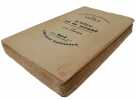"SARTRE, J.-P.
L'être et le néant. Essai d'ontologie phénoménologique. - [THE MAIN WORK OF EXISTENTIALISM - FIRST PRINTING, REVIEW-COPY]
Paris, nrf, Librairie Gallimard, 1943. 8vo. Orig. printed wrappers, uncut and first quire unopened. Light traces of use, but overall remarkably fresh. Spine very slightly darkened and wrappers with very light scattered brownspotting. A small, vague couloured thump bark to lower corner of front wrapper (and first leaves). An unusually good copy, as the fragile wrappers are often much more worn. Also internally unusually fresh. Wrappers printed in red and blue. With half-title. 722, (2) pp, 2ff. (one with colophon).
Reference : 60084
The very rare first edition, first impression from ""Bibliothèque des idées"" printed on 25th of June 1943 (""Le vingt-cinq juin mil neuf cent quarante-trois"" (colophon) ), rare review-copy (with ""S.P. - Service des Presses) to back wrapper. With the printed dedication ""au CASTOR"" (i.e. for Simone de Beauvoir""). This, the first edition of Sartre's first and main philosophical work, which is one of the absolutely most important philosophical works of the 20th century, passed virtually unnoticed, as it appeared in the summer of 1943, which is why it is now extremely scarce. It didn't reach recognition till 1945, thus very few copies of the first edition have been preserved. ""Achevé au debut de 1943, le livre parut en été et, étant donné les circonstances, passa à peu près inapercu. Il fallut attendre 1945, année aù la vogue soudaine de Sartre attira sur son oeuvre maîtresse une attention qu'aucun ouvrage philosophique n'avait connue précédemment, pour que les commenteurs s'en ampareut"" (Contat & Rybalka p. 86). Even though the work was hardly noticed when it first appeared, a few scholars acknowledged it as a great work of seminal character, importance and novelty; in 1964 Michel Tourier writes: Un jour de l'automme 1943, un livre tomba sur nos tables: ""L'Être et le Néant"". Il y eut eu moment de stupeur, puis une longue rumination. L'oeuvre était massive, hirsute, débortante, encyclopédique, superbement technique..."" (Les Nouvelles littéraires, 29 octobre 1964).Sartre is first and foremost known for his philosophical works, and as ""L'être et le néant"" (""Being and Nothingness"") is generally accepted as his greatest and main work, this marks the beginning of 20th century existentialism, and furthermore ""has also come to be regarded as a text-book of existentialism itself..."" (Mary Warnock's Introduction to Hazel E. Barnes' translation). This, his seminal work of existentialism, marks one of the most influential philosophical movements of our age.Contat & Rybalka, Les Écrits de Sartre, 1970.
Bookseller's contact details
Herman H. J. Lynge & Son
William Schneider
Silkegade 11
1113 Copenhagen
Denmark
+45 33 155 335
Payment mode
Sale conditions
All items may be returned for a full refund for any reason within 14 days of receipt.
 Write to the booksellers
Write to the booksellers





